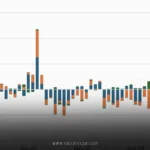Impact of Federal Reserve Policies on Stock Market Performance is something every investor should pay close attention to, right? Imagine the Fed as the conductor of a massive orchestra—the economy—where each policy tweak sends ripples through the stock market, sometimes creating harmonious gains and other times causing discordant drops. You’ve probably felt it yourself: one announcement from Fed Chair Jerome Powell, and your portfolio swings like a pendulum. But why does this happen, and how can you make sense of it all? In this deep dive, we’ll unpack the intricate dance between the Federal Reserve’s decisions and stock market vibes, drawing on real-world examples to keep things relatable. Whether you’re a newbie dipping your toes into investing or a seasoned trader, understanding the impact of Federal Reserve policies on stock market performance could be your secret weapon for smarter decisions.
Let’s start by breaking it down simply. The Federal Reserve, or the Fed as we casually call it, isn’t just some distant bureaucracy; it’s the U.S. central bank tasked with keeping the economy humming along. Congress gave it a dual mandate: maximize employment and stabilize prices, which basically means fighting inflation without tanking jobs. But here’s the kicker—their tools, like tweaking interest rates or buying bonds, don’t just affect banks; they echo loudly in Wall Street. When the Fed hikes rates to cool off inflation, borrowing gets pricier for companies, potentially squeezing profits and dragging down stock prices. On the flip side, rate cuts can feel like injecting rocket fuel into the market, encouraging spending and investment. Ever wondered why your tech stocks soar during low-rate eras? That’s the impact of Federal Reserve policies on stock market performance in action, making growth-oriented sectors thrive while value stocks might lag.
What Exactly is the Federal Reserve, and Why Does It Matter for Stocks?
Picture the Fed as the economy’s thermostat—if things get too hot with inflation, they turn up the dial on rates; if it’s chilly with recession fears, they dial it down. Established back in 1913 after a string of financial panics, the Fed’s main gig is monetary policy. But how does this tie into your 401(k)? Well, the impact of Federal Reserve policies on stock market performance stems from how these policies influence liquidity, borrowing costs, and investor sentiment. For instance, when the Fed signals tighter policy, investors might flock to safer assets like bonds, pulling money out of stocks and causing dips.
Think about it this way: stocks are essentially bets on future company earnings. If Fed policies make it harder for businesses to borrow and expand—say, through higher interest rates—those earnings projections dim, and poof, stock prices adjust downward. Conversely, loose policies flood the system with cheap money, boosting corporate investments and consumer spending, which often lifts stock valuations. It’s like adding fertilizer to a garden; everything grows faster. But don’t get me wrong, it’s not always straightforward. Market reactions can be knee-jerk, driven by expectations rather than actual changes. Remember, the stock market is forward-looking, so even hints of policy shifts can spark volatility.
To build trust here, I’m drawing from solid economic principles and recent data. For example, studies show that a surprise 25-basis-point rate cut can juice broad stock indexes by about 1% on average. That’s not pocket change when you’re talking about trillions in market cap. As someone who’s followed these patterns for years, I can tell you it’s crucial for beginners to grasp this basics before diving deeper into the impact of Federal Reserve policies on stock market performance.
Key Federal Reserve Policies and Their Direct Impact on Stock Market Performance
Diving into the toolbox, the Fed has a few heavy hitters that directly shape the impact of Federal Reserve policies on stock market performance. Let’s chat about the big ones, shall we?
Interest Rate Adjustments: The Heartbeat of Market Moves
Interest rates are the Fed’s go-to lever, and boy, do they pack a punch. The federal funds rate—that overnight lending rate between banks—sets the tone for everything from mortgages to corporate loans. When the Fed hikes this rate, it’s like slamming on the brakes: borrowing costs rise, companies cut back on expansions, and consumers tighten belts. Result? Slower economic growth, which often translates to lackluster stock performance, especially in rate-sensitive sectors like real estate or utilities.
Take 2022-2023, for instance. The Fed jacked up rates aggressively to tame post-pandemic inflation, pushing the funds rate from near-zero to over 5%. Stocks took a beating—the S&P 500 dropped about 20% at its nadir— as higher rates made bonds more attractive and crimped corporate profits. Fast-forward to late 2024, when the Fed started cutting rates by 1% total, and markets rebounded sharply, with the S&P 500 hitting new highs by mid-2025. Why? Lower rates reduced borrowing costs, spurring investment and lifting earnings outlooks. It’s a classic example of the impact of Federal Reserve policies on stock market performance flipping from negative to positive.
But here’s a rhetorical question: What if rates stay high too long? We saw hints in early 2025, with the Fed holding steady at 4.25%-4.50% amid tariff worries from the Trump administration. This caution stemmed from fears that tariffs could reignite inflation, keeping rates elevated and pressuring stocks into volatility. Analogous to a seesaw, when rates go up, stocks often tip down, and vice versa. For investors, tracking FOMC meetings is key—those dots plots forecasting future rates can be gold.
Quantitative Easing: The Fed’s Money-Printing Magic Trick
Then there’s quantitative easing (QE), where the Fed buys up bonds to inject liquidity into the system. Think of it as flooding the market with cash to lower long-term rates and encourage lending. During the COVID-19 crisis, QE ballooned the Fed’s balance sheet to over $8 trillion, propping up stocks amid economic shutdowns. The impact of Federal Reserve policies on stock market performance here was massive—equities surged as cheap money flowed into assets.
On the flip side, quantitative tightening (QT), where the Fed sells bonds or lets them roll off, sucks liquidity out, potentially cooling markets. Post-2022, as the Fed unwound QE, we saw tighter financial conditions, contributing to stock wobbles. But in 2025, with no major QE restarts amid stable growth, markets have adapted, though any hint of renewed easing could spark rallies. It’s like adding or removing fuel from a fire—the impact of Federal Reserve policies on stock market performance through QE is all about liquidity flow.
Other Tools: Forward Guidance and the Discount Rate
Don’t forget forward guidance—the Fed’s way of telegraphing future moves to shape expectations. A dovish hint (easing ahead) can boost stocks overnight, while hawkish talk (tightening) sends them tumbling. The discount rate, another borrowing tool for banks, also signals policy stance. These nuances amplify the overall impact of Federal Reserve policies on stock market performance, making transparency a double-edged sword: it reduces uncertainty but can amplify reactions.
Historical Lessons: Tracing the Impact of Federal Reserve Policies on Stock Market Performance Over Decades
History is our best teacher, isn’t it? Looking back, the impact of Federal Reserve policies on stock market performance has shaped bull and bear markets alike. In the 1980s, under Paul Volcker, aggressive rate hikes to crush double-digit inflation tanked stocks initially but paved the way for the longest bull run in history as rates fell. Fast-forward to the dot-com bust in 2000; Alan Greenspan’s rate cuts fueled a housing boom but also sowed seeds for the 2008 crisis.
The Great Recession? Ben Bernanke’s QE rounds saved the day, with stocks tripling from 2009 lows as liquidity poured in. More recently, during COVID, Jerome Powell’s zero-rate policy and massive QE turned a 34% S&P plunge into a V-shaped recovery. But 2022’s hikes reminded us of the pain: tech-heavy Nasdaq fell over 30% as growth stocks got hammered.
What stands out is asymmetry—the “Fed put.” When stocks tank, the Fed often eases policy faster than when they boom, acting as a safety net during downturns. This pattern underscores how the impact of Federal Reserve policies on stock market performance isn’t neutral; it’s more reactive to pain, boosting confidence in bad times but risking bubbles in good ones.
The 2025 Landscape: Current Impact of Federal Reserve Policies on Stock Market Performance
As we sit here in August 2025, the Fed’s stance is cautious. After cutting rates in late 2024, they’ve paused at 4.25%-4.50%, eyeing Trump-era tariffs that could spike inflation. Markets have been choppy—the S&P dipped 20% early in the year but recovered to all-time highs by mid-summer, thanks to steady earnings and no recession signals. Yet, uncertainty lingers: if tariffs bite, higher rates could persist, pressuring stocks.
Emerging trends? The Fed’s focus on data-dependency means every jobs report or CPI release can sway markets. For sectors, tech and growth stocks love low rates, while financials benefit from higher ones. Globally, Fed moves ripple out—emerging markets like Korea felt the pinch from 2022 hikes, with foreign investors fleeing. The impact of Federal Reserve policies on stock market performance in 2025 hinges on balancing inflation control with growth support, keeping investors on their toes.
Strategies for Investors: Navigating the Impact of Federal Reserve Policies on Stock Market Performance
So, how do you play this? First, diversify—don’t put all eggs in rate-sensitive baskets. Use ETFs for broad exposure. Second, stay informed: follow Federal Reserve announcements for clues. Third, consider hedging with options or bonds during tightening cycles.
For long-term folks, remember: markets climb walls of worry. Rate hikes hurt short-term but often signal a healthy economy. As an experienced observer, I’d say timing the market based on Fed moves is tricky—better to invest consistently and adjust allocations. Tools like dividend stocks can buffer volatility. Ultimately, understanding the impact of Federal Reserve policies on stock market performance empowers you to react smartly, not panic.
Conclusion
Wrapping it up, the impact of Federal Reserve policies on stock market performance is profound, influencing everything from daily trades to long-term trends through rates, QE, and guidance. We’ve seen historical booms and busts, recent pauses amid tariff fears, and strategies to thrive. Key takeaway? The Fed doesn’t target stocks directly but their actions create waves we all ride. Stay educated, diversify, and view policy shifts as opportunities, not threats. Whether rates rise or fall, informed investors win. Now’s the time to review your portfolio—don’t let the next Fed move catch you off guard!
FAQs
1. How does a Federal Reserve rate hike directly affect the impact of Federal Reserve policies on stock market performance?
A rate hike increases borrowing costs, potentially slowing growth and lowering stock prices, especially in growth sectors. It’s like adding weight to a runner—performance dips until adaptation.
2. What role does quantitative easing play in the impact of Federal Reserve policies on stock market performance?
QE injects liquidity, lowering long-term rates and boosting asset prices. During crises, it’s a lifeline, but tapering can cause temporary dips as markets adjust.
3. Why might the Fed pause rate changes, and how does that influence the impact of Federal Reserve policies on stock market performance?
Pauses, like in 2025 due to tariffs, create uncertainty, leading to volatility. Markets hate unknowns, so stocks might trade sideways until clarity emerges.
4. Can individual investors predict the impact of Federal Reserve policies on stock market performance?
Not perfectly, but watching economic data and FOMC dots helps. Use resources like Investopedia’s Fed guide for insights—it’s about probabilities, not certainties.
5. How have recent 2025 developments altered the impact of Federal Reserve policies on stock market performance?
With rates steady amid inflation risks, stocks recovered from early dips but remain sensitive. Check CNBC’s Fed coverage for updates—tariffs add a wild card.
For More Updates !! valiantcxo.com


